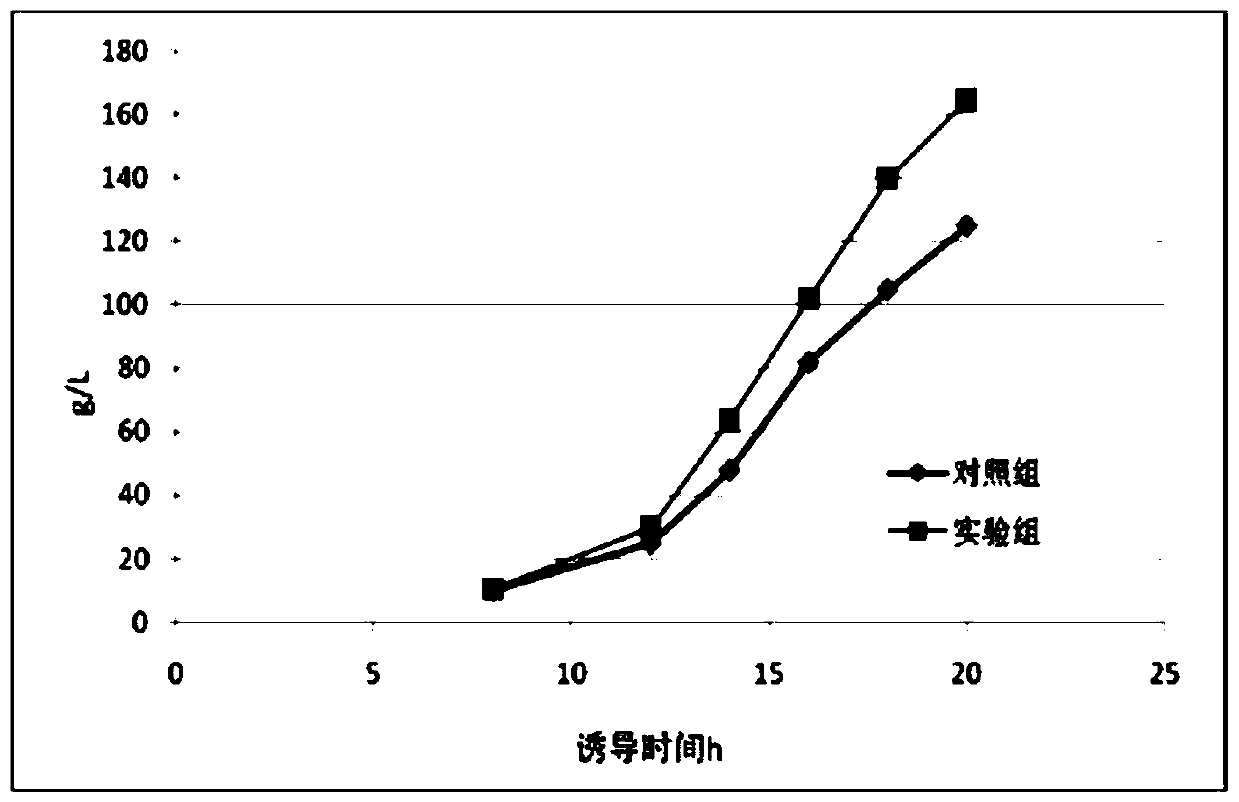Cytoskeleton polymerase as well as preparation method and application of cytoskeleton polymerase
A cell scaffold and polymerase technology, applied in the field of molecular biology, can solve the problems of inability to meet the demand of L-lysine, low acid production level and conversion rate of L-lysine, and achieve the improvement of sugar-acid conversion rate, Increase concentration, improve the effect of metabolic processes
- Summary
- Abstract
- Description
- Claims
- Application Information
AI Technical Summary
Problems solved by technology
Method used
Image
Examples
preparation example Construction
[0029] The embodiment of the present invention provides a method for preparing a cell scaffold polymerase, which is characterized in that it comprises the following steps:
[0030] Using the Escherichia coli gene as a template, perform PCR amplification in a pre-set amplification system to obtain the capsid protein gene, two complementary helical peptide genes and the aspartokinase gene;
[0031] amplifying the capsid protein gene and two complementary helical peptide genes by an overlapping PCR method to obtain a cell scaffold gene;
[0032] The cell scaffold gene and the plasmid vector are digested and ligated to obtain the cell scaffold gene recombination vector;
[0033] The cell scaffold gene recombination vector and the aspartokinase gene are digested and ligated to obtain the cell scaffold polymerase gene recombination vector;
[0034] The cell scaffold polymerase gene recombination vector is transformed into Escherichia coli competent cells by a heat shock method, and...
Embodiment 1
[0047] Amplification primer design: Design the capsid protein PduA gene, two complementary helical peptide CC-Di-A, CC-Di-B genes and aspartokinase LysC in the Escherichia coli genome through primer design principles and various computer programs Gene amplification primers, and through a large number of experiments to screen out the primer sequence with high specificity, wherein the capsid protein PduA gene amplification primers are primer 1PduA-up, SEQ ID No.1 and primer 2PduA-down, SEQ ID No.2; Helical peptide CC-Di-A gene amplification primers are primer 3CC-Di-A-up, SEQ ID No.3 and primer 4CC-Di-A-down, SEQ ID No.4; helical peptide CC-Di-B gene Amplification primers are primer 5CC-Di-B-up, SEQ ID No.5 and primer 6CC-Di-B-down, SEQ ID No.6; aspartokinase LysC gene amplification primer is primer 7LysC-up, SEQ ID No.7 and primer 8LysC-down, SEQ ID No.8, see Table 1 for details.
[0048] Table 1 Amplification Primer Nucleotide Sequence
[0049] Primer name Primer...
Embodiment 2
[0055] The cell scaffold gene CC-Di-A-PduA-CC-Di-B obtained in Example 1 and the Escherichia coli expression plasmid PET-24a were double-digested with BamHI and ScaI restriction endonucleases respectively, and the enzyme digestion system was: 2.5 μl of 10x digestion buffer, 1 μl of each restriction enzyme, 16 μl of plasmid / scaffold gene, ddH 2 O4.5 μl, heated in a water bath at 37°C for 30 minutes, recovered by enzymatic digestion, and stored at -20°C.
[0056] The cell scaffold gene CC-Di-A-PduA-CC-Di-B and the expression plasmid PET-24a recovered from the above enzyme-digested gel were connected to the expression vector and the target fragment using T4 DNA ligase. The connection system was: double enzyme digestion Rear Fragment C-Di-A-PduA-CC-Di-B 5 μl, double digested plasmid PET-24a 3 μl, T4 DNA Ligase (DNA ligase) 1 μL, 10xT4 DNA Ligase Buffer (DNA ligation buffer) 1 μL, at room temperature The ligation reaction was carried out for 10 minutes under the condition, and the...
PUM
 Login to View More
Login to View More Abstract
Description
Claims
Application Information
 Login to View More
Login to View More - R&D
- Intellectual Property
- Life Sciences
- Materials
- Tech Scout
- Unparalleled Data Quality
- Higher Quality Content
- 60% Fewer Hallucinations
Browse by: Latest US Patents, China's latest patents, Technical Efficacy Thesaurus, Application Domain, Technology Topic, Popular Technical Reports.
© 2025 PatSnap. All rights reserved.Legal|Privacy policy|Modern Slavery Act Transparency Statement|Sitemap|About US| Contact US: help@patsnap.com

